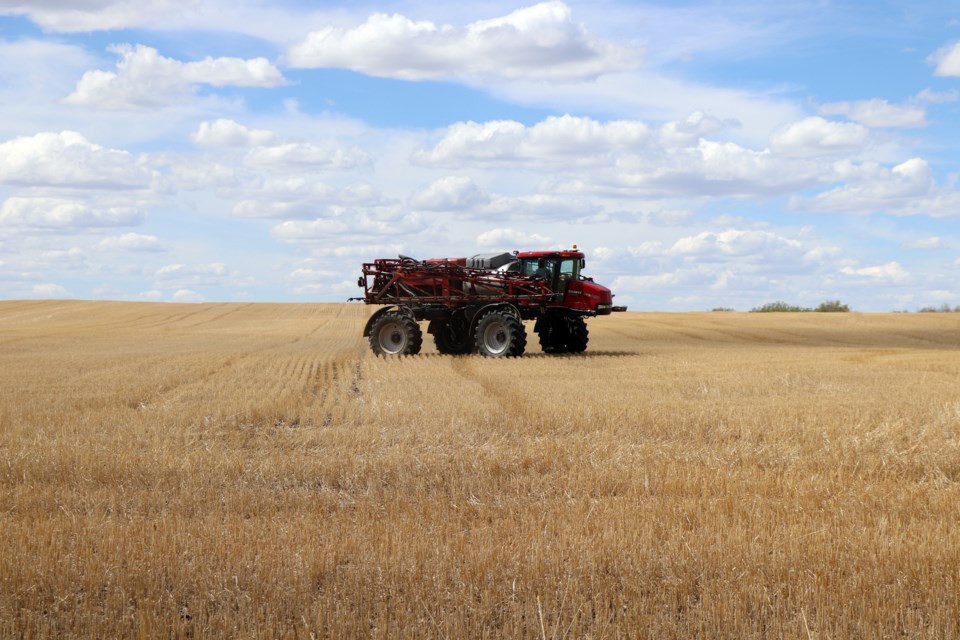INNISFAIL – While some areas of the province may be experiencing disastrous conditions for farmers as they move into harvest, Red Deer County farmers and ranchers should make it through with a less worrisome but still disappointing “below average year.”
Cody McIntosh, agricultural services manager for Red Deer County, said area producers in relation to others in the province are still feeling the extended hot and dry conditions. But in comparison to a normal year, it’s just considered “low on moisture.”
“It’s a below average year for most producers. It’s hard to call things a disaster, yet but our neighbours to the north, south, east and west have even less moisture to deal with,” said McIntosh. “Of course, being below average moisture, we could use it all over the place.”
While acknowledging other areas, notably in the south and north, are facing greater moisture problems, he noted in the past couple of weeks there’s been a “little bit” of moisture in a band across Central Alberta, including a part of Red Deer County three weeks ago in the Lacombe and Red Deer areas, where an inch of rain fell.
“Sporadic showers have definitely been to the benefit of some producers. I was driving by some canola and it looked like it was more than belly deep,” said McIntosh. “That’s a decent canola crop, just looking at it from the road. With the high humidity we’ve had in the morning and the dew point in that, a lot of these low areas are getting some moisture every night.”
Nevertheless, he’s noticed pastures around Bowden, where there’s a lot of cattle grazing, as well as in the Innisfail area, are short on grass.
“Pastures are low and it’s spotty for what we see for moisture,” said McIntosh, adding Bowden did experience a moisture benefit from hail. “Bowden is pretty famous for getting good hail storms. There was a hail storm earlier this season but I don’t know if it did a lot of damage but sometimes those big summer storms can bring in a lot of moisture in, which could have been useful here a month ago.”
But not necessarily now, he added. McIntosh said many producers, with an eye on the approaching harvest season, will want big dumps of moisture to hold off for just a while longer.
“They (producers) need a lot of moisture over the next six months but right now we are coming into harvest with all of our cereal grains, and moisture will be a challenge for them,” said McIntosh. “A lot of rain would cause a problem for these guys trying to harvest a below average yield, and now they are going to have trouble getting it off. It is going to kind of compound their problems.
“I don’t want to say we don’t want anything right now to the benefit of these cereal grain producers, but if it could hold off and they can harvest what they have, then get a good recharge here over the late fall and into winter is what we need,” he said, emphasizing the county has experienced about 14 months of below average moisture. “Since last spring we haven’t had enough, so we need a good six to eight, 10 months of moisture to build us back up.”
As far as yields go for this year, McIntosh said if producers were banking on an “average year” they will be facing one with less money. He noted markets have been “extremely strong”, which will help the producers that do have a good crop, but with yields being reduced compared to what was once hoped, they will be short of expectations, especially when considered against 2020, which he said was a “great year” for county producers.
“You would call it a bumper crop. Yields were about 120, 130 per cent of average, so they were great off the fields and the markets were really strong in the fall. They got even better over the winter and coming this spring, so the markets are really strong right now,” said McIntosh. “It was shaping up to be an excellent year and now we can’t produce enough to capitalize on these strong markets.”
McIntosh declined to offer a number for this year but reiterated yields will be “below average”, and in some areas “well below average.”
As for the start of harvest, McIntosh said it should start “any time”, noting harvesting in southern areas of peas and cereals has already begun. He said this region’s peas should start this week, and cereals a week after, which would be a week or two ahead of schedule.
He noted last year the region had a good dry, warm harvest season and producers found themselves ahead of typical timelines.
“The crop came out with great yields, good quality and earlier on time and this year is going to be a couple weeks early,” said McIntosh.



